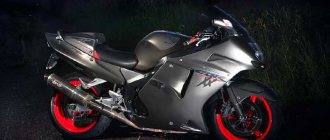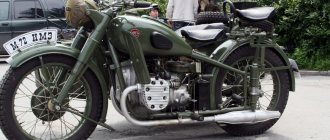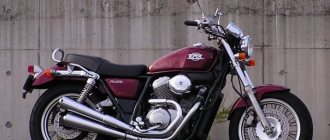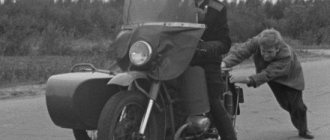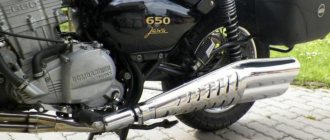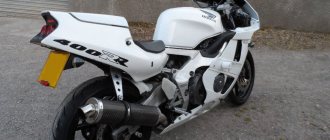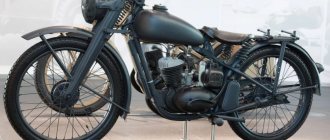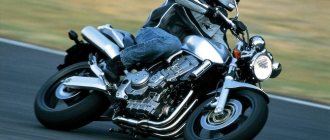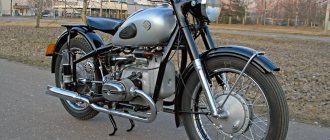The first steps of the USSR motorcycle industry
At the very end of 1924, at the former (in those years it was called plant No. 1 OSOAviaKhim) in Samara, a sample motorcycle was manufactured and assembled.
The motorcycle and engine were an original design. But at the same time they contained a lot of solutions borrowed from various foreign motorcycle manufacturers. The four-stroke engine developed about 10 horsepower and had one cylinder. The gas distribution mechanism had a bottom-mounted exhaust valve driven by the camshaft. The exhaust valve stood in a non-removable cylinder head and worked from the vacuum in the cylinder that occurs during the downward stroke of the piston.
The motorcycle took part in a successful test run, but it did not reach mass production.
The first IZH motorcycles
Another center for the development of motorcycle production was the Izhevsk Mechanical Plant. It was in Izhevsk that a design bureau was formed under the leadership of Pyotr Vladimirovich Mozharov, thanks to whose many works the motorcycle industry arose in the USSR.
The main products of the Izhevsk plant in those years were small arms - Maxim machine guns and Mosin rifles. The high-precision equipment and high production standards available at the plant were well suited for the manufacture of motorcycle parts. Mozharov Design Bureau has created several types of motorcycles. Some of them had purchased engines (from the German company Wanderer), and several were equipped with engines of their own design.
The high workload of the plant with army orders did not allow mass production of any of these vehicles. A few years later, in Izhevsk they began to assemble the IZH-7 motorcycle, which was a copy of the motorcycle of the German company DKV. Work on adapting the motorcycle design to production conditions in the USSR was carried out by the same P.V. Mozharov.
History[ | ]
By decree of the Supreme Economic Council of October 5, 1931, a decision was made to produce motorcycles for the Red Army in the USSR. At the end of the same year, a group led by Pyotr Vladimirovich Mozharov (creator of one of the earliest models) began constructing a heavy two-cylinder motorcycle with an engine capacity of 750 cc [2].
The development was carried out at NATI, so the first name of the motorcycle became NATI-A-750. The letter “A” meant that this version could be equipped with a sidecar for use on highways and good dirt roads. Without a stroller, there were no restrictions on the quality of roads. The number “750” corresponded to the rounded value of the engine displacement[3].
Prerequisites for the creation of PMZ-A-750
Mastering the production of IZH-7 and L-300 motorcycles identical in design (produced in Leningrad) made it possible to begin supplying them to the army. But these machines were light, and the army needed heavy motorcycles that could be used with a side trailer.
The starting models for creating a heavy motorcycle were American cars (Harley & Davidson). Motorcycles of this brand were supplied to the USSR in fairly large volumes and performed well.
Development of NATI-A-750
The decision to create a motorcycle was made by a decree of the National Economy Council in the fall of 1931. In accordance with the decree, work began on designing a motorcycle with a two-cylinder engine and a displacement of 750 cc.
The work took about a year and was carried out at NATI in a separate Design Bureau of Motorcycle Engineering under the leadership of P.V. Mozharov. In addition to Mozharov, many talented designers worked in the bureau, such as I. Okunev and B. Fitterman, who would later become leading designers of automotive equipment in the USSR. The new model received the NATI-A-750 index, where the letter “A” indicated the ability to operate the vehicle with a side trailer (only on paved roads), and the numbers denoted the rounded working volume of the cylinders.
The production and assembly of the first samples of NATI-A-750 motorcycles was carried out at the end of 1932 in Izhevsk. Trial tests of the engines showed their performance and gave power readings from 16 to 18 forces, which corresponded to the original task and calculations. In the spring of next year, the motorcycles successfully passed the test run from Izhevsk to Moscow.
However, a new decree was soon issued - on the development of production of IZH-7 in Izhevsk and on the transfer of production of NATI-A-750 to Podolsk
Story
The Supreme Council of the National Economy decided to produce two-wheeled vehicles for the Red Army. In 1931, work began on creating a heavy two-cylinder, 750 cc monster. It was developed at the Scientific Research Automobile and Automotive Engine Institute, in connection with this its first name was NATI-A-750, and the number 750 was a rounding of the engine displacement.
After the release of the first four 1.05 vehicles in 1933, it was tested along the route from Izhevsk to Moscow. This made it possible to launch heavy motorcycles into mass production at the Podolsk Mechanical Plant.
The PMZ-A-750 motorcycle was produced from 1934 to 1939.
There were interruptions in the performance of the engine ignition timing regulator; at a speed of 45 kilometers per hour, increasing vibrations of the front wheel began. The PMZ motorcycle became practically uncontrollable and there was a high probability of the motorcycle overturning and injury. Since 1939, production of the PMZ 750 was stopped and, starting in 1941, production of the M-72 began. In which the entire BMW R 71 was taken as a sample.
Appearance of the designation PMZ-A-750
For the production of motorcycles, the Podolsk Mechanical Plant (PMZ) was allocated space, which for many years produced sewing machines, simultaneously fulfilling various military orders. P.V. Mozharov was again appointed to organize production at the new location.
The development of production proceeded with great difficulty, since the plant did not have the necessary equipment, technology and qualified employees. As a result, P.V. Mozharov never saw the mass production of his brainchild - in the spring of 1934 he committed suicide.
In the summer of 1934, PMZ-A-750 motorcycles were shown to People's Commissar S. Ordzhonikidze, who approved the design and demanded the speedy establishment of large-scale production. It was established the following year and lasted four years. During this time, more than 4,630 motorcycles were assembled.
The PMZ-A-750 motorcycle was supplied to the army, various government agencies (police, NKVD) and sold into private hands. The maximum speed of the motorcycle reached 90 km/h with an average consumption of about 6 liters of low-octane A56 gasoline per 100 km. The motorcycle had a solid, but unfinished design. The engine ignition system caused especially a lot of criticism; it was not without reason that one of the comic decodings of the PMZ was the phrase “Try to Start Me.” Another defect was the phenomenon of front fork resonance at speeds of about 40 km/h. After the death of P.V. Mozharov, there was practically no modification of the design. In addition, work began in the USSR to create more advanced machines, which led to the creation of the famous M-72.
These facts led to the cessation of production of the motorcycle in 1939. The Podolsk plant never returned to assembling motorcycles.
Design of PMZ-A-750
Structurally, the motorcycle was a mixture of solutions from German and American motorcycle schools. The frame and chassis were created with an eye on German BMW motorcycles. The duplex frame was assembled from two trusses from separate stamped elements.
The gas tank for the PMZ-A-750 with a capacity of about 21 liters was located between the trusses of the front part of the frame. The front fork made of stamped profiles was equipped with an 8-leaf spring, which partly softened shocks from road unevenness. The rear wheel had no suspension and was rigidly attached to the frame.
The four-stroke engine was an almost complete copy of Harley-Davidson products. The motor of the PMZ-A-750 motorcycle had two cylinders arranged in a V-shape. The power of serial engines did not exceed 15 horsepower. Start the engine with a foot pedal. The gas distribution system was driven by gears.
A three-speed gearbox was located in the same crankcase with the engine. Torque from the engine to the gearbox was transmitted through a multi-plate clutch. The engine was equipped with a circulating lubrication system with a “dry sump” (powered from a separate oil tank with a capacity of 2.25 liters) and a 6-volt battery ignition system. The ignition system included a generator, coil and distributor. Rear wheel drive is chain.
Both wheels of the motorcycle had drum brakes, driven by a pedal (rear drum) and a lever on the handlebar (front drum).
The motorcycle could work with a sidecar. The stroller had a welded frame and was attached to the motorcycle frame using three ball joints. The body of the stroller with one passenger seat made of steel sheet was suspended from the frame on two leaf springs.
Development
In the early 30s, the Scientific Automotive and Tractor Institute (NATI) was asked to develop a heavy motorcycle with a power of 750 cm3, adapted to the road conditions of the USSR and suitable for use with a sidecar. To develop the project, designer Pyotr Vladimirovich Mozharov, creator of the first IZH motorcycles, was invited to Moscow.
The working group reviewed existing design solutions from the American company Harley-Davidson and the German BMW, drawing a number of ideas. Young designers Alexander Fedorov, Igor Okunev, Sergei Semashko, Boris Fitterman and others provided invaluable assistance in the creation of the PMZ-A-750. Later, Fedorov worked as the chief engineer of the plant in Irbit. Okunev became the chief designer of the Moscow Engine Plant, and then the AZLK Automobile Plant. Fitterman participated in the development of ZIS cars.
